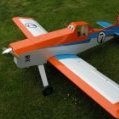-
Posts
4,902 -
Joined
-
Last visited
-
Days Won
10
Content Type
Profiles
Forums
Blogs
Gallery
Calendar
Downloads
Everything posted by Gary Manuel
-
Thanks for your feedback fellas
-
Hi Ultimate, You are saying the same as everyone else, but is this from experience?
-
A friend of mine brought a pushy cat (similar model) to our field and asked me if I would hand launch it for him. I took one look at it and reallised that my hand would pass close to the spinning prop as it left my hand. We discussed the launch technique and agreed that an underhand launch in a continuous flowing action bending at my elbow would result in my hand moving upwards away from the prop at the point of launch. Both parties did as discussed and the launch went fine. I would launch it again for him any day. In other words - we did a risk assessment, came up with a safe method of working and stuck to it.. Now about whether this sort of accident should result in a claim - That should depend on whether there is any permanent damage that affects the injured persons ability to carry out day to day activities. If not, there should be no claim. Don't forget, the insurance is there for us all, if we find ourselves in this unfortunate position, but it's also paid for us all through the BMFA membership. The more claims we make, the higher the premiums will be. or the level of cover will be reduced. That's the way insurance works. We should all do our bit and only make genuine claims. The odd cut and bruise is all part of the hobby. Sorry if I'm playing down your injury Diamond. You didn't say whether anything was permanently damaged or not. Hope you are OK and your injury is not as bad as it looks (this is usually the case) and you make a full recovery. Please let us know how you get on with your injury and with your claim if you pursue it. Edited By Gary Manuel on 13/04/2014 09:34:10
-
Right - as I said in my first posting, this build log has been transferred from my local club forum (I'm not that quick at building) This is where I got to so we are now going live. Edited By Gary Manuel on 13/04/2014 09:09:36
-
Now that what I call a rear end! Just pushed in for now.
-
Now for the tail feathers: All tail components skinned on the remaining side and roughly sanded to shape. Slot cut in the fuselage to accept the stabiliser And then the rudder. The designer shows the rear former being cut as shown here to allow the rear surface of the tail fin to be level with the rear of the fuselage as shown in red (photo edited, not marked on the model!). If pushed in without doing anything it needs to be moved forwards by the thickness of the former (3mm). I think its a better idea to leave the rear former intact and to cut a piece out of the fin - like this. It might just cause a problem when it comes to placing the bottom hinge. We'll have to see later when I fit the rudder horn and steerable tail wheel assembly which will all fight for the same space. Edited By Gary Manuel on 13/04/2014 09:05:31
-
The epoxied captive nut / ply washer was then cyano'd to the under-side of the wing bolt box using the 8mm hole as a guide viewed from above. 6mm steel bolt with a couple of washers and oversize nuts prepared ready to pull the captive nuts into the washers. Bolt / washer / nut assembly screwed through the wing bolt box into the captive nut. Captive nut not pulled into the ply yet. Socket set used to tighten the bolt. Captive nut pulled into the ply. Epoxy will hold it there and is well clear of the threads.This technique works for undercarriage and engine mount captive nuts also.
-
Wings pretty much complete. Time to sort out the wing fixing. Remember earlier when I added a block of balsa inside the trailing edge at the wing bolt position? I drilled the 6mm holes (pilot drilled then increased in size) through the wing and into the wing bolt box in the fuselage. The holes through the wing are solid balsa, so it looks like I got my sums right The holes in the wing box were then drilled out to 8mm to accept the thick central part of the captive nuts This is a trick I always use for securing the captive nuts Use a ply washer, or make them up as here. I've made it 6mm thick by gluing 2 offcuts together. Mark the position of the captive nut spikes by pressing them into the washer Then drill them out with a 1.5mm drill. This helps the captive nut penetrate the ply washer without slipping, twisting or splitting the ply. Apply epoxy between the captive nut and ply washer - it shouldn't get into the thread because the central part of the captive nut is a close fit with the 8mm hole in the ply washer.
-
Now for the wing tips. Offcuts of 12mm stuck to the lite-ply wing tip former to form the basic leading edge shape And the trailing edge Sheeting added from the leading edge to the main spar position. A bit of bending was necessary here Edge triangle added for strength and after a bit of shaping the wing tips look like this I later added offcuts of balsa to the tip rib to fill in the oval hole and add strength to the tip former. Edited By Gary Manuel on 13/04/2014 08:46:28


















